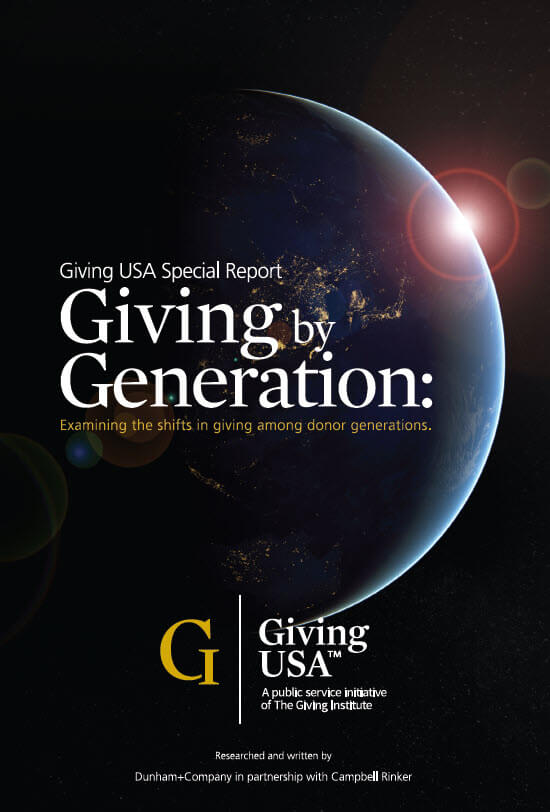Knowing what inspires each generation to give to your nonprofit is important to ensuring your financial stability as an organization. While Baby Boomers and Generation X are the majority of donors today, Millennial and Gen Z donors will need to be stewarded for the future prosperity of your nonprofit. Qgiv’s Generational Giving Study focuses on the information that nonprofits need for current and future fundraising. Giving USA’s Special Report, “Giving by Generation: Examining the Shifts in Giving Among Donor Generations” also addresses generational giving. In this blog post, we’ll compare the results of the two studies to determine the perfect way to reach out to your donors regardless of which generation they belong to.

A Summary of “Giving by Generation”
- Millennials surpassed Gen X in annual household giving
- Millennials volunteer the most
- Donations to places of worship are decreasing
- Smartphone and tablet donations are on the rise
- Direct mail is still important
- Generation Z is the most motivated to give monthly
- Matching grants encourage giving
- The younger the generation, the more they want updates
Giving USA’s Giving by Generation report compares generational giving from 2022 against generational giving reported in their 2016 generational study. Here are some of the most interesting finds from the latest iteration of their “Giving by Generation” study.
1. Millennials surpassed Gen X in annual household giving
One surprising finding is that Millennials reportedly gave more per household than Generation X. This means that Millennials may be reaching a point of economic security in which they have enough cash after bills to afford to make more substantial donations. What does this mean for nonprofit organizations? It’s time to take Millennial donors seriously and steward them (if you haven’t already started doing so). While they may not be giving on the same level as Baby Boomers, Millennials are proving that they’re a charity-minded generation that wants to support causes that resonate with them.
2. Millennials volunteer the most
Another interesting finding about Millennials is that they volunteer the most out of all of the generations according to the “Giving By Generation” study. This further reinforces that Millennials want to support charities by giving more than just money. They also devote their time! When stewarding Millennials, don’t forget to offer them volunteer opportunities so that they can make a direct impact on your cause by donating their time.
3. Donations to places of worship are decreasing
Places of worship saw a decrease in donations from 2016 to 2022, meaning that Baby Boomers, Generation X, and Millennials are giving less to places of worship. This data wasn’t available for Generation Z. However, Generation Z was the only generation of the three not to prioritize religious organizations with their donations. That said, Millennials were the most likely to give to and engage with places of worship. To make up for lost donations, churches need to start finding ways to engage more with Millennial donors.
4. Smartphone and tablet donations are on the rise
In 2016, only 25% of all donors in the Giving by Generation study reported donating via a smartphone or tablet. This number has steadily increased since 2016. Now, 48% of Generation Z, 47% of Millennials, and 41% of Generation X have reported making a gift via a smartphone or tablet in 2022. Even 27% of Baby Boomers have given via smartphone or tablet! The takeaway here is that your online donation forms need to be mobile friendly if you want to capture donations made on these devices. The age of pinching and scrolling has come to an end. Donors expect a streamlined and efficient process or else they won’t complete their gifts. Look into solutions like Qgiv’s online donation forms to ensure you’re offering your donors a great experience regardless of the device they use.
5. Direct mail is still important
One shocking finding is how important direct mail is to fundraising. Even with advancements in technology like email and text messaging, donors welcome direct mail as a preferred method of communication. More than half of Millennial respondents rated themselves as being motivated to respond to a direct mail appeal. They share the stage with Baby Boomers who also prefer direct mail communication. The takeaway here is to not give up on direct mail appeals just yet. Instead, be sure to include Millennials in direct mail appeals as they’re motivated to respond to them like their Baby Boomer predecessors.
6. Generation Z is the most motivated to give monthly
Gen Z may be the best generation to target for small recurring gifts. As they grow and achieve more financial independence, this generation may grow their support, creating a lot of sustainable income for nonprofit organizations. As of right now, 62% of Gen Z donors stated they would prefer to give monthly. Comparatively, only 58% of Millennials, 35% of Gen X, and 18% of Baby Boomers wanted to give monthly according to the study. This means that targeting Gen Z and Millennials for recurring giving campaigns will show better results than trying to get Generation X and Baby Boomers to give on a recurring basis. Our best guess is that this is because Gen Z and Millennials are more accustomed to subscription-based services and are used to paying monthly subscription fees. In this case, they’d be donating on a recurring monthly basis to make it possible for nonprofits to provide the services they perform to better the world.
7. Matching grants encourage giving
An unsurprising finding we want to mention is that matching grants encourage giving across the generations. One thing every generation agreed on was that they were more likely to give if they knew their gift would be matched. Doubling the difference was a big motivator according to the “Giving by Generation” study. 64% of all donors polled reported that they were highly motivated by the prospect of their donation being matched. Millennials were most likely to be motivated to give if a match was offered.
8. The younger the generation, the more they want updates
Generation Z and Millennials want monthly updates from charities. 70% of Generation Z and 64% of Millennials reported wanting monthly updates from the nonprofits that they support, while Baby Boomers and Generation X preferred quarterly updates on the workings of the charity. This means that the way we communicate with donors as Millennials and Gen Z become higher-dollar donors has to change. Instead of sending quarterly newsletters, switching to a monthly report of activities is essential to keeping these donors engaged with your nonprofit organization.
How does this compare to Qgiv’s Generational Giving Report?
Millennials were most likely to give to places of worship
Like the “Giving by Generation” report, Millennials appeared to be the most motivated to give tithes and offerings to places of worship. 34% gave tithes and offerings alone, which was the highest out of every generation polled. And also like the “Giving by Generation” report, Gen Z was least likely to be motivated to give to religious organizations.
Monthly updates are the way to keep Millennial and Gen Z donors engaged
Just like Giving USA’s report, the Generational Giving Report indicated that Millennials and Gen Z donors preferred monthly updates from the nonprofits that they support. This is a strong indicator that Millennials and Gen Z donors want more from nonprofits. They expect status updates on projects frequently and want to know that their donations are being used wisely.
One interesting difference
One interesting difference between Qgiv’s Generational Giving Study and the “Giving by Generation” report from Giving USA was information on where Millennials donated. While “Giving by Generation” showed that Millennials gave more to places of worship and faith-based institutions, the three verticals the Generational Giving Report showed Millennials giving to were research and public policy, international affairs, and education. That doesn’t mean that these three verticals don’t include religious nonprofits in them, but we did find it interesting that places of worship wasn’t a top vertical for Millennials polled in the “Generational Giving Report.”
Key takeaways
- Start taking Millennials seriously as a source of donations. They now give more per household than Generation X and are highly motivated to make a difference in the world.
- Donations to places of worship are decreasing, but Millennials may be key to righting the ship. Find ways to engage Millennials, who are most likely to make tithes and offerings to places of worship out of all the generations.
- Make donation forms mobile friendly to capture smartphone and tablet donations
- Direct mail appeals to more than just Baby Boomers. Millennials also prefer to receive direct mail and are motivated to give in response to direct mail appeals.
- Gen Z donors are more likely to agree to give monthly. When you want to find recurring donors, start by stewarding this motivated generation.
- Matching gift grants motivate more donations across all generations.
- Millennials and Gen Z prefer monthly updates from your nonprofit.
Conclusion
There you have it! These were some of the most interesting findings from the Giving by Generation study by Giving USA. The Generational Giving Study we produced corroborates a lot of the information shared here, so you can confidently reach donors by each generation and abide by their communication and giving preferences.



